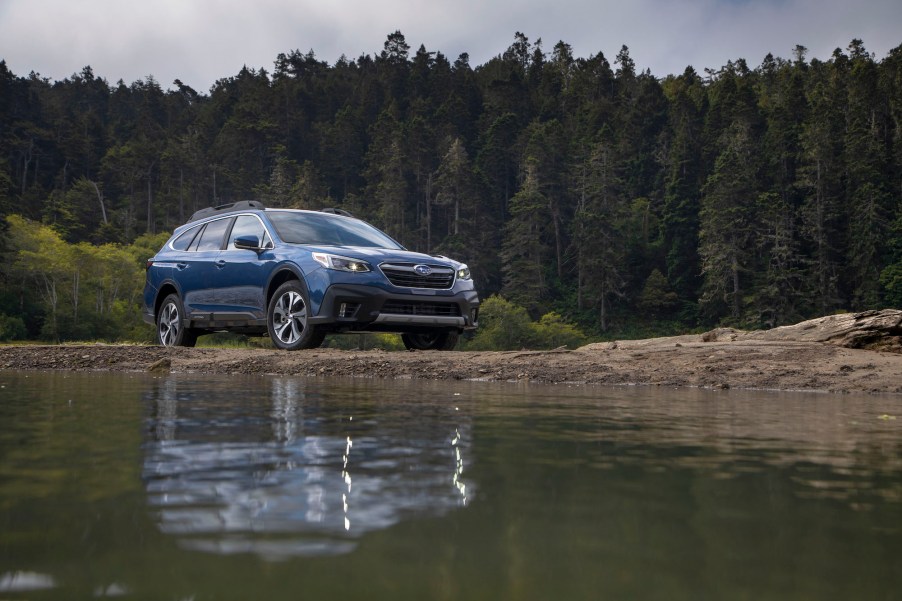
Consumers and Experts Can’t Agree on the Best 2021 Subaru Outback Trim
For over a quarter-century, the Subaru Outback has uniquely bridged the gap between station wagons and SUVs. It’s doing something right because its popularity has never waned. It boasts the ground clearance and driving position of an SUV, it looks like a hatch, but it drives like a car.
The 2021 Subaru Outback is upscale, roomy, and versatile. It also provides plenty of value across six trim levels. But consumers and some industry experts disagree about which trim level is the best.
The Subaru Outback Premium and Onyx Edition XT trims
Edmunds’ “select a trim” feature shows that most consumers purchase the Subaru Outback Premium trim. However, Edmunds recommends the Onyx Edition XT. It packs more features and a more powerful turbocharged engine than the Premium trim.
But although the Premium is only level up from the base-model Outback, it’s still impressive. The standard model’s 2.5-liter four-cylinder engine produces 182 hp and pairs with a smooth-shifting continuously variable automatic transmission. The turn-adaptive LED headlights are also a high-end feature.
Plus, even the base-model Subaru Outback comes with Android Auto and Apple CarPlay standard with a 7.0-inch touchscreen infotainment system and automatic climate control. It also offers great driver-assist features like adaptive cruise control, forward-collision warning, automatic high beams, and lane-keep assist.
The Premium trim adds LED fog lights, tinted rear windows, and a windshield wiper de-icer with the All-Weather package. Inside, you get a power-adjustable driver’s seat, leather-wrapped steering wheel, 11.6-inch touchscreen infotainment system, and dual-zone automatic climate control.
Plus, the Premium trim also brings blind-spot monitoring, rear cross-traffic alerts, keyless entry and start, navigation, and a sunroof. You can also add a hands-free power liftgate.
Car and Driver agrees with consumers that the Subaru Outback Premium model is the best trim to buy. C/D’s reviewers appreciate its balance between standard and available options for the money. They say this model’s engine provides enough power, and they appreciate the comfort and convenience features.
The Subaru Outback Limited trim
However, MotorBiscuit likes the Subaru Outback Limited trim. It has the same powertrain as the Premium model but adds luxury to an already great driving experience. The Limited model adds leather trim on the dash and perforated leather seats. The driver’s seat gets upgraded to 10-way power adjustability with a cushion extension and two memory settings. The front passenger seat gets eight-way power adjustability, and the rear seats are heated.
The Limited trim also adds reverse automatic braking, steering-adaptive LED headlights, and 18-inch wheels. Plus, the mirror on the passenger side tilts down when you’re in reverse. You can also add an optional package with a driver-distraction mitigation system, a heated steering wheel, and a power moonroof.
Why is the Premium trim a consumer favorite?
As the folks at Car and Driver pointed out, the Subaru Outback Limited costs almost $6,000 more than the Premium. In their opinion, the acceleration boost and additional 800 pounds of towing capacity aren’t worth the investment. Not when the engine under the Premium’s hood has more than enough power, and it’s loaded with features.
Apparently, many consumers share this view.
Still, if you have the money to spare, the Limited trim offers plenty of luxury and convenience features even without the optional package. It’s also spacious enough for your family and all its gear.
A solid competitor to the Honda Passport, Hyundai Santa Fe, and Toyota 4Runner, the 2021 Subaru Outback has a lot to offer a family on the go. It was redesigned in 2020, and in 2021 it added adaptive headlights, a rear-seat reminder system, and passenger seatbelt warning with audible and visual cues across its lineup. Overall, the Outback offers an impressive balance between comfort and value.


